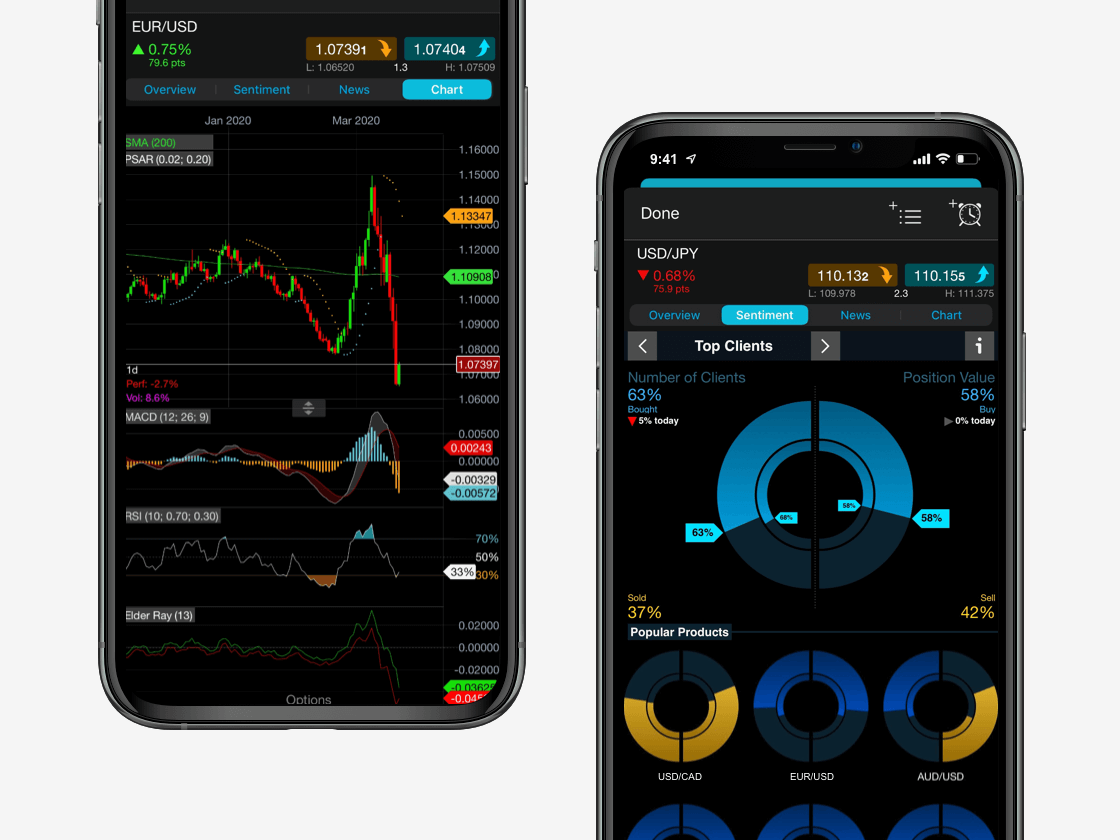Stock market sectors are a set of categories into which companies and their stocks are sorted based on the primary nature of their business. Devised by S&P Global and Morgan Stanley Capital International (MSCI), the Global Industry Classification Standard (GICS) contains 11 official stock market sectors.
11 stock market sectors: how to gain exposure to each one
Understanding the different stock market sectors can help traders and investors both spread their risks and make better-informed decisions. Read on for insight into how to get exposure to particular sectors and the factors that move them.
What are stock market sectors?
Why trade stock market sectors?
Trading within stock market sectors enables investors to gain exposure to industries that are expected to benefit from particular market-moving factors. Trading on stock market sectors rather than individual companies can reduce the risk of investments completely failing as your risk is spread out across many companies.
At CMC Markets, we now offer exclusive sector share baskets, which include a wide range of topical categories, so that you can access a number of shares using one single position using CFDs. Trading on our share baskets is a form of thematic investing that gives you access to your desired sectors.
Get exposure to the world's fastest-growing, trending industries, from Driveless Cars to Streaming Media
List of different sectors in the stock market
1. Information Technology
Information Technology, or IT, is the sector concerned with the creation and distribution of technologies related to data and other forms of information. Information Technology includes many large, established companies but due to the highly innovative nature of the sector, it also contains plenty of newer, growth-oriented companies.
It includes three main industry groups:
- Software & Services. Examples include Salesforce [CRM] and Microsoft [MSFT]
- Technology Hardware & Equipment. Examples include Apple [AAPL] and Intel [INTC]
- Semiconductors & Semiconductor Equipment. Examples include Nvidia [NVDA] and Taiwan Semiconductor Manufacturing Company [TSM]
The easiest way to distinguish between these industries is to think of Software & Services as all those products and businesses relating to computers that don’t involve a physical product, such as a word processing application or an IT consultancy. Companies specialising in areas like cloud computing, data analytics and machine learning/artificial intelligence (AI) will generally be categorised as Software & Services companies.
Hardware & Equipment includes producers of computers, telephones, networking devices and the various other physical products (besides semiconductors) involved in the manufacture and use of computers and related information-sharing technologies.
Companies involved in the manufacture of semiconductors are classified in the Semiconductor & Semiconductor Equipment industry.
Investors and traders can select ETFs with a focus on certain areas of the IT sector for broad exposure to different elements of this large and varied space. For example, the Vanguard Information Technology ETF provides exposure to some of the largest global IT companies, while the Global X MSCI China Information Technology ETF provides specialised exposure to China’s IT sector.
Alternatively, Our Big Tech share basket offers exposure to many of the biggest names in the IT sector, including Microsoft, Facebook and Apple. Similarly, the SaaS (Software as a Service) share basket provides exposure to companies involved in cloud computing and related technologies, including Zoom, HubSpot and Salesforce.
IT stocks typically carry large premiums (reflecting the growth prospects of start-ups like Palantir or the ubiquity of established firms like Microsoft). However, this carries with it the risk that many tech stocks can be over-inflated, with unprofitable companies buoyed by growth potential until the market gives up on them. Rapid obsolescence cycles also increase volatility in IT stocks.
2. Financials
Companies within the Financials sector hold and move money and other financial assets. It can be split into the following industries:
- Banks. Examples include JPMorgan Chase [JPM] and Lloyds Banking [LLOY]
- Diversified Financials. This includes sub-industries like consumer finance, mortgage real estate investment trusts (REITs) and capital markets
- Insurance. This includes all forms of insurance, such as health, life, property and reinsurance. Examples include Warren Buffett’s Berkshire Hathaway [BRK] and Allianz [ALV]
Given the outsized proportion of the Financials sector that banks account for, interest rates and the policies of central banks tend to be the most significant market-moving factors in the sector. Low interest rates encourage individuals and businesses to borrow money, which increases Financials sector revenues. Because their primary business lies in lending to and investing in other sectors, the performance of Financials companies’ typically depend on the performance of other sectors, and the health of the economy overall. Read our guide to trading on financial stocks.
Traders can gain exposure to regional banking industries via CFDs— for example, UK Banks or US banks — using our share baskets. Alternatively, ETFs like the Financial Select Sector SPDR Fund provide exposure to a broad range of financial institutions.

3. Healthcare
Two industries comprise the Health Care sector:
- Health Care Equipment & Services and Pharmaceuticals. Examples include Cardinal Health [CAH] and GlaxoSmithKline [GSK]
- Biotechnology & Life Sciences. Examples include Bristol Myers Squibb [BMY] and Novo Nordisk [NOVO]
Health Care Equipment & Services includes companies that specialise in producing equipment and supplies for health care; companies that provide or distribute services and facilities for health care; and companies involved in developing health care technology.
Pharmaceuticals, Biotechnology & Life Sciences companies include those that develop biological technologies like gene editing; pharmaceuticals companies that specialise in drugs, vaccines and other treatments; and life sciences tools and services companies.
Outbreaks of infectious diseases, such as the coronavirus pandemic, can positively impact the health care sector by increasing investment for research and development and demand for treatments. MRNA vaccine names such as Moderna [MRNA], BioNTech [BNTX] and Pfizer [PFE] are companies that benefited throughout the pandemic.
Other positive market-moving factors for the Health Care sector are ageing populations and increasing life expectancies for people with chronic diseases, although single-payer health care systems such as Medicare are headwinds.
Genomics-focused ETFs like the ARK Genomic Revolution ETF offer investors exposure to the biotech industry specifically, while the Vanguard Health Care ETF offers broad exposure to the overall sector.
4. Consumer Staples
The Consumer Staples sector refers to companies that produce or sell goods that everyone needs and buys, regardless of their financial status. It includes industries such as:
- Food, Beverage & Tobacco. Examples include Nestlé [NESN] and PepsiCo [PEP]
- Food & Staples Retailing. Examples include Walmart [WMT] and Costco [COST]
- Household & Personal Products. Examples include Procter & Gamble [PG] and Unilever [ULVR]
Because they are considered essential goods, consumer staples experience fairly consistent demand year-round and are relatively unaffected by market-moving factors. As such, the Consumer Staples sector is often a popular choice during recessions and among investors seeking safe returns and dividends with minimal volatility.
However, companies that specialise in consumer staples face strong competition on price, so are under constant pressure to minimise costs by modernising their operations as much as possible (for example, the rise of self-checkouts at supermarkets is a response to the need to minimise staff costs).
The Fidelity MSCI Consumer Staples Index ETF offers investors and traders exposure to the Consumer Staples sector by tracking the performance of the MSCI USA IMI Consumer Staples Index. Alternatively, the iShares US Consumer Goods ETF offers exposure to both the Consumer Staples and Consumer Discretionary sector in the US.
5. Consumer Discretionary
The Consumer Discretionary sector is distinguished from Consumer Staples by the greater impact that consumers’ financial status has on demand. Economists refer to this as price elasticity of demand.
The sector includes:
- Automobiles & Components. Examples include luxury manufacturers such as Tesla [TSLA] and Porsche [PAH3]
- Consumer Durables & Apparel. Examples include Amazon [AMZN] and iRobot [IRBT]
- Consumer Services (such as hotels and restaurants). Examples include McDonald's [MCD] and Starbucks [SBUX]
- Retailing (excluding food & staples). These goods and experiences are non-essential, but highly desirable to consumers with sufficient purchasing power
Unlike Consumer Staples, the Consumer Discretionary sector experiences greater demand during periods of economic growth, when consumers have more disposable income. GDP and consumer confidence are two key indicators of consumers’ willingness to spend money on non-essential items, as opposed to saving.
Our Luxury Lifestyle share basket offers investors and traders exposure to companies specialising in Consumer Discretionary products. Alternatively, there are ETFs dedicated to the sector, such as the Consumer Discretionary Select Sector SPDR Fund.

6. Communication Services
This is a relatively new GICS sector, and it contains two component industries which both keep people connected and broadcast information:
- Telecommunication Services. Examples include AT&T [T] and Verizon Communications [VZ]
- Media & Entertainment. Examples include Google’s parent company Alphabet [GOOGL] and Netflix [NFLX]
The Telecommunication Services industry includes wireless and diversified telecommunication services companies — essentially, telephone and internet network providers.
The Media & Entertainment industry includes advertising, broadcasting, and cable and satellite companies, as well as publishing.
The Communication Services sector was created by re-categorising some companies that had previously been IT or Consumer Discretionary and merging them with the pre-existing Telecommunications sector.
Traders seeking exposure to the Communication Services sector can select ETFs such as the Vanguard Communication Services ETF. Specialised share baskets such as Social Media, Streaming or 5G offer exposure to the sector’s constituent industries.
While individual Communication Services stocks can be volatile, the sector as a whole has experienced sustained growth and its stocks occasionally exhibit both growth and value traits.
7. Real Estate
The Real Estate sector contains two industries:
- Real Estate Investment Trusts (REITs). These act similar to mutual funds as pools into which investors can contribute resources for investment in real estate. Examples include American Tower [AMT] and Hammerson [HMSO]
- Developers and managers of real estate projects. Examples include CBRE Group [CBRE] and Brookfield Asset Management [BAM]
Real Estate has historically been considered one of the safest investments. House prices have tended to rise consistently over long periods of time. Periods of recession, like the 2008 financial crisis, tend to lower house prices, but their effects tend to be short-lived and house prices then continue to trend upwards. For example, US house prices had recovered to pre-crisis levels by 2013.
Low interest rates can be a particularly positive market-moving factor for the sector, as they encourage prospective homebuyers to borrow and spend more on property.
REITs can be traded as a means of gaining exposure to the Real Estate sector. Alternatively, traders and investors can select specialised ETFs such as the iShares Developed Markets Property Yield UCITS ETF or the Real Estate Select Sector SPDR Fund.

Seamlessly open and close trades, track your progress and set up alerts
8. Utilities
There are five industries included in the Utilities sector, each of which corresponds to a different type of utility provided to customers. These include:
- Electric Utilities, such as Tokyo Electric Power [9501]
- Gas Utilities, such as Centrica [CNA]
- Water Utilities, such as Severn Trent [SVT]
- Independent Power and Renewable Electricity Producers, such as NextEra Energy [NEE]
- Multi-Utilities, such as Engie [ENGI]
The sector doesn’t include producers of traditional fossil fuels, like oil and gas companies. Many Utilities companies are specialised according to geography and/or the type of utility provided (e.g. Duke Energy in the Southeast US, or Canadian Solar).
Utilities companies tend to be heavily regulated. Like the Consumer Staples sector, they generate steady returns regardless of market-moving factors, and as such, can be used to defend portfolios against economic downturns. In this sense, Utilities companies are typically value stocks (those trading below their real worth), although current trends towards clean energy also give the sector significant growth potential.
Investors can access the renewable electricity industry through our Renewable Energy share basket, or alternatively, ETFs such as the iShares S&P 500 Utilities Sector UCITS ETF offer broad exposure to the sector.
9. Energy
While renewable forms of electricity consumption are included in the Utilities sector, Energy encompasses all other forms of energy production — specifically, oil, natural gas, and coal.
Its two constituent industries involve companies specialised in the tools required to extract these resources, and those doing the extracting, respectively, including:
- Energy Equipment & Services. Examples include Baker Hughes [BKR] and Natural Gas Services Group [NGS]
- Oil, Gas & Consumable Fuels. Examples include ExxonMobil [XOM] and Royal Dutch Shell [RDS]
Many large energy companies, such as BP and Equinor, are diversifying their operations into the renewables industry. Integrated power companies like these are classified in the Energy sector.
Oil prices have a strong bearing on the performance of Energy companies, although different companies are affected differently. Producers of oil perform strongly during periods while its price is high, but oil refiners benefit when oil prices are lower. The amount of volatility in oil prices may make energy stocks attractive to speculators. Demand for fossil fuels has fallen in recent years thanks to growing demand for renewables and the impact of the coronavirus pandemic.
Our Oil and Gas share basket offers traders convenient exposure to the Energy sector, as do specialised ETFs such as the Energy Select Sector SPDR Fund.

10. Industrials
Industrials is a broad sector comprising everything from airlines to defence companies. Its three constituent industries contain 14 sub-industries between them:
- Capital Goods, such as Caterpillar [CAT]
- Commercial & Professional Services, such as Lockheed Martin [LMT]
- Transportation, such as United Parcel Service [UPS]
Industrials companies usually perform well during periods of growth and poorly during recessions. However, given how broadly specialised various companies within the sector are, there are frequent exceptions to this general rule.
ETFs such as the Vanguard Industrials ETF offer traders exposure across the sector.
11. Materials
The Materials sector contains companies specialised in:
- Metals & Mining, such as Glencore [GLEN]
- Chemicals, such as DuPont [DD]
- Construction Materials, such as Saint Gobain [COD]
- Paper & Forest Products, such as Kimberly-Clark [KMB]
- Containers & Packaging, such as Krones [KRN]
Companies in the sector extract and process raw materials before selling them to all other industry sectors. As such, its demand-side market-moving factors are particularly closely tied to the performance of the broader economy.
The gold mining industry can be accessed through our US Gold share basket, while the iShares Global Materials ETF offers sector-wide exposure.
Disclaimer: CMC Markets is an execution-only service provider. The material (whether or not it states any opinions) is for general information purposes only, and does not take into account your personal circumstances or objectives. Nothing in this material is (or should be considered to be) financial, investment or other advice on which reliance should be placed. No opinion given in the material constitutes a recommendation by CMC Markets or the author that any particular investment, security, transaction or investment strategy is suitable for any specific person. The material has not been prepared in accordance with legal requirements designed to promote the independence of investment research. Although we are not specifically prevented from dealing before providing this material, we do not seek to take advantage of the material prior to its dissemination.

